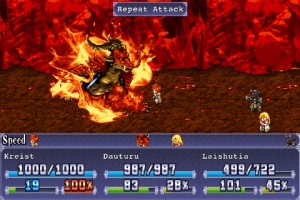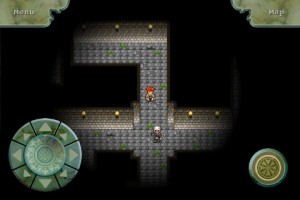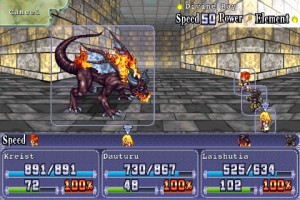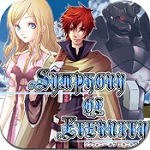The JRPG is a rare animal on iOS. It’s little wonder, because it’s probably the most difficult genre to get right. A great JRPG has to have everything: an interesting cast of characters and an attractive presentation to reel the player in, and gameplay mechanics interesting enough to keep him or her hooked for the long haul. Kemco has bravely stepped forward to establish a new beachhead for the genre, and one of its opening salvos is Symphony of Eternity (Out Now, $4.99 Sale). In terms of gameplay it’s a surprisingly solid start. Now, if only the player didn’t have to squint so hard to see its strengths!
Kemco’s translation team competently delivers Symphony’s story, the script faring best when it tends toward humor. Its story holds great dramatic potential as well, and it’s agonizing to see this go untapped by virtue of plot structure. A coup d’état and a kingdom in peril should have made for a rich kickoff, especially when the hero and his big metallic sidekick befriend a character who vaguely resembles the princess deposed in the intro. I had my suspicions and looked forward to being strung along by a gradually unraveling mystery, but the obvious question is bluntly put to rest in Symphony‘s first ten minutes. A humdrum quest for a magical substance ensues, robbing that critical first hour of the narrative oomph it needs to really capture a jaded RPG fan’s interest. That said, if you’re a fan of lighthearted character banter and don’t really need a thought provoking tale to help you sink into an RPG, you’ll still get plenty of mileage out of the funny quips the hero and his dutiful sidekick constantly deliver.
 Symphony offers gameplay systems that are far more interesting than its plot. Per genre tradition, gameplay can be broken down into three distinct parts: exploration, battling, and character micromanagement. I’ll address character micromanagement first, because this is where Symphony really shines. The game has a class system governed by “Tablets,” which can be thought of as instruction booklets containing skills. A character can automatically use all skills contained within the Tablet currently assigned to him or her, but once the skills are mastered through accumulation of Tech Points, those skills remain with the character permanently — even when a completely different Tablet is assigned! For example, the player can temporarily swap out the hero’s Knight class for the Cleric class, master a low-level healing spell before switching back, and end up with a tough character who can dish out major damage but also heal in a pinch. Once the player is just a couple hours in, he or she will be swimming through class options if care has been taken to explore for Tablets and purchase them in shops. This is seriously cool, and I’m sure just the sound of it has piqued the interest of any Final Fantasy fans who may be reading. On the downside, the Tablet system makes no changes to character appearance or the type of equipment he or she can use.
Symphony offers gameplay systems that are far more interesting than its plot. Per genre tradition, gameplay can be broken down into three distinct parts: exploration, battling, and character micromanagement. I’ll address character micromanagement first, because this is where Symphony really shines. The game has a class system governed by “Tablets,” which can be thought of as instruction booklets containing skills. A character can automatically use all skills contained within the Tablet currently assigned to him or her, but once the skills are mastered through accumulation of Tech Points, those skills remain with the character permanently — even when a completely different Tablet is assigned! For example, the player can temporarily swap out the hero’s Knight class for the Cleric class, master a low-level healing spell before switching back, and end up with a tough character who can dish out major damage but also heal in a pinch. Once the player is just a couple hours in, he or she will be swimming through class options if care has been taken to explore for Tablets and purchase them in shops. This is seriously cool, and I’m sure just the sound of it has piqued the interest of any Final Fantasy fans who may be reading. On the downside, the Tablet system makes no changes to character appearance or the type of equipment he or she can use.
Also very cool is the Merit Point system, which functions just like the Level Up points familiar to KRPG fans — albeit with one very important difference. Points assigned by the player can be un-assigned and flow back into a general reservoir, which allows for stat shifting as the situation demands. Facing a tough boss that casts devastating spells? Remove any Merit Points assigned to physical stats and apply to them to magic defense instead! The further the player progresses and the more characters level up, the more leeway the player has to address sudden challenges. This essentially wipes out the need for “level grinding,” which will be music to the ears of just about any RPG fan.
 Symphony’s strengths extend into exploration. It’s very reminiscent of Crimson Gem Saga in letting the player view and ambush enemies while wandering around — and note, enemies can also ambush the player’s party if they catch the hero with his back turned. Area minimaps are one tap away while exploring. The world map can similarly be zoomed out to get a bird’s eye view and reveal the next stop on the hero’s agenda in case the player’s returning from a long break. Symphony even has the courtesy to warn the player before a boss battle occurs, giving him or her a last chance to back off and heal before triggering it. How’s that for convenience?
Symphony’s strengths extend into exploration. It’s very reminiscent of Crimson Gem Saga in letting the player view and ambush enemies while wandering around — and note, enemies can also ambush the player’s party if they catch the hero with his back turned. Area minimaps are one tap away while exploring. The world map can similarly be zoomed out to get a bird’s eye view and reveal the next stop on the hero’s agenda in case the player’s returning from a long break. Symphony even has the courtesy to warn the player before a boss battle occurs, giving him or her a last chance to back off and heal before triggering it. How’s that for convenience?
Symphony’s turn-based combat system presents the player’s party and enemies in side-view perspective, and feels visually reminiscent of Final Fantasy VI: enemies are exquisitely drawn but sadly lack animations, and the player character sprites are attractive but barely animated themselves. It’s important to note that Symphony doesn’t use an Active Time Battle system with turns coming up on the fly. Rather, the player enters commands for the entire party at once, and then the current turn plays out according to relative agility of characters and enemies.
 Once a turn has started, the order of actions can be broken if one or more characters have a full “Break” gauge. This is useful for two situations as far as I’ve gathered: if your party’s in critical condition and you need a slow character to execute a healing spell pronto, or for chaining the heroes’ offensive actions together for damage bonuses. That latter possibility makes the combat system really fun when the opportunity arises, but like Crimson Gem Saga’s slick combo system, Symphony’s Break system is blunted because the designers didn’t seize on the idea as strongly as they needed to. The Break gauge fills at an agonizingly slow rate, making it something to be held in reserve during normal battles and unleashed once or twice during boss battles.
Once a turn has started, the order of actions can be broken if one or more characters have a full “Break” gauge. This is useful for two situations as far as I’ve gathered: if your party’s in critical condition and you need a slow character to execute a healing spell pronto, or for chaining the heroes’ offensive actions together for damage bonuses. That latter possibility makes the combat system really fun when the opportunity arises, but like Crimson Gem Saga’s slick combo system, Symphony’s Break system is blunted because the designers didn’t seize on the idea as strongly as they needed to. The Break gauge fills at an agonizingly slow rate, making it something to be held in reserve during normal battles and unleashed once or twice during boss battles.


